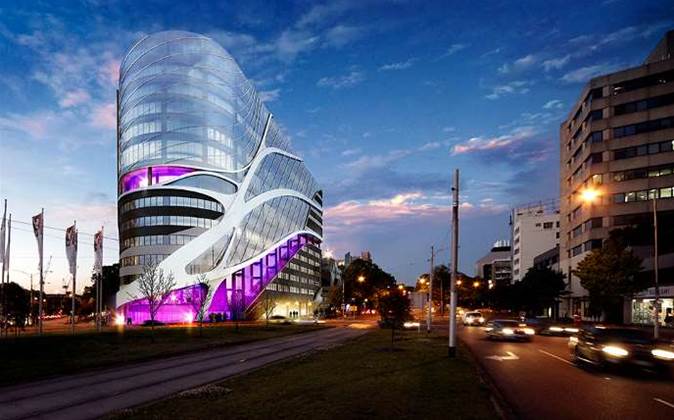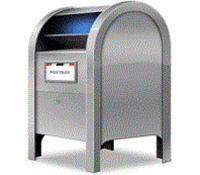This article has been reviewed according to Science X's editorial process and policies. Editors have highlighted the following attributes while ensuring the content's credibility:
fact-checked
trusted source
proofread
The tech inside Victoria's $1bn cancer care facility
Using cutting-edge hospital technology to improve the healthcare experience of cancer patients is one of the main objectives in a $50 million IT deployment at a new healthcare and biomedical research facility in Melbourne.

Scheduled to open in the middle of next year, the $1 billion Victorian Comprehensive Cancer Centre (VCCC) will bring together research, treatment, care and education services from 10 partner organisations into a single building.
The project is being constructed through a private-public partnership and has received a total of $854.6 million in funding from the federal and state governments, with the remaining funds provided from the partners.
VCCC ICT lead Rod Sprenger told iTnews a total of $50 million had been put aside for the centre's technology, covering network, cabling, patient and nursing systems and servers.
“This has been the premier project for digital hospitals in Victoria, and we’ve been very satisfied with the results so far,” Sprenger said.
The centre wants to improve the patient experience through the use of digital healthcare technologies - starting from the moment a patient walks through the door.
“When people arrive at the hospital for the first time, they’re not going to know where anything is. So we’ll have wayfinding systems that will operate much like the ones you find in a shopping centre,” Sprenger said.
Patient letters will come equipped with barcodes that patients can scan at the hospital to print out a map of where they need to go, and will also check them into the system and automatically notify the correct area that the patient has arrived.
“It solves the issue of queues. Now they can sit in a waiting lounge and see when their appointment is coming up on a large screen," Sprenger said.
"If they check in an hour early, they can go to the hospital cafe and be notified by text message when their appointment time is.”
Dial-a-nurse
Traditional nurse call units send a standard buzz to the nearest clinician when pressed, but don't differentiate whether the patient needs urgent care or a glass of water.
It’s a problem the VCCC aims to solve by using an integrated messaging suite that will send nurse calls from patients and medical alerts to staff through clinical handsets.
“We’re using the Rauland Responder 5 nurse call systems at the bedside. Rather than just sending an undifferentiated buzz to a nurse, it allows the patient to speak directly to a nurse, call for a drink or say they’re in pain. It also logs the patient’s location,” Sprenger said.
“That allows us to better direct them to the right person. So if it’s a patient who wants a glass of water, you’d send that request through to a clerk on the ward rather than a clinician.
“The clinical handsets we’re using are Ascom Myco clinical mobile handsets. They look like a smartphone, but are purpose-built for the hospital environment. They can handle being dropped or be cleaned with hospital-grade disinfectants and still work.”
If, for whatever reason, a clinician can’t handle a request, the system allows it to be escalated to another member of staff.
“We’re also putting a workflow terminal in each patient room," Sprenger said.
"So if a clinician needs to get clean sheets, a room cleaned or transport a patient, they can send that message at the touch of a button. And it will automatically be sent to the clinical mobile handset of the right person with the location of the job."
Keeping patients entertained
Not only will the centre offer patients a Linux-based patient entertainment system - known as HiMed Cockpits - to access free-to-air TV, movies on demand, games, radio and the internet to get them through their hospital stay, patients will also be able to utilise integrated video conferencing.
"[The PexIP system] allows anyone to conference a patient directly from their web browser by keying in a secure ID, without needing to download a proprietary client," Sprenger said.
“We think that capability will be especially important for patients with loved ones interstate, overseas, or in remote areas that might not be able to regularly visit in person."
Full video conferencing is also being implemented in three of the operating theatres, allowing clinicians two-way conversations with outside specialists or for remote training.
Roaming profiles
While hospital staff need secure access to information, the logistics of this is made challenging by the need for clinicians to move from patient to patient, bed to bed and ward to ward.
It’s an issue Sprenger is looking to address through the deployment of virtual desktops and XenDesktop roaming profiles.
“A nurse can go up to any terminal and pull up a patient’s electronic medical records, including patient and drug charts,” Sprenger said.
“And through their roaming profile, they can just swipe their smartcard at any of the terminals and get nearly instant access to their desktop and whatever application they were using.
“That’s not just integrated into the computers, it’s integrated with the HiMed Cockpit terminal as well. So if a nurse wants to educate a patient about a topic relevant to their treatment, they can use the patient entertainment terminal to pull up the relevant details."
Behind the scenes
All of the new patient- and clinician-facing systems have been designed to integrate into core clinical systems, using the HL7 messaging protocol.
The centre's infrastructure is also designed to allow researchers from Melbourne Health, the University of Melbourne and other partners to remotely access their files and applications over the network from the VCCC.
“We’ve built a very capable network with 99.999% redundancy based on Cisco Nexus 7710 switches at the core. It’s robust but open and flexible, and allows researchers to connect directly into their applications from the organisation they belong to," Sprenger said.
“Behind the scenes we have a 108 rack on-premises, tier 3-equivalent, high-availability, high-redundancy data centre.
“It’s very important to protect information from compromise and critical systems from failure, especially given how much the centre relies on ICT. We also have a secondary back-up data centre off-site in case anything happens.”
Change management
For all the new medical technology deployed in the VCCC, perhaps the most crucial challenge faced by Sprenger’s team has been change management.
“Moving from the old environment [Peter MacCallum Cancer Centre, which will be subsumed into the VCCC] to the new environment requires a robust change management journey. And we see it as a journey, rather than as a process,” Sprenger said.
“It’s about making sure all the staff have a taste of what’s to come, so when they move across it’s a welcome across to the world they expect.
“We’re putting over 2500 staff into this new facility, so it’s important they’re ready to make the move.”
One of the most critical success factors, according to Sprenger, has been to build a team with the right people.
“How we’ve addressed that challenge is through strong governance, and keeping all parties in the loop at all times throughout the project – from design, build, and testing – communications have been very strong,” Sprenger said.
“There’s been an enormous number of sub-contractors involved, with different technologies and different ways of working.
“The most important thing is how the vendors and systems come together, so we’ve put in place a standard approach to documentation, integration and processes.
“The conversation when the vendor comes on board isn’t one where they say: ‘Hi, I’m vendor A, here’s how I do things’. The conversation is: ‘Hi, welcome to the VCCC, and here’s the standard way we do things.’”
Looking into the new year, Sprenger said he was optimistic about the progress his team has made so far.
“The technology implementation is just about complete. They’re currently undergoing independent third party reviews to make sure everything meets specifications," he said.
“From February 2016 we forecast we’ll begin the transition in, including staff training and acceptance testing, and then in mid-2016 we’ll be open to the public.”


















